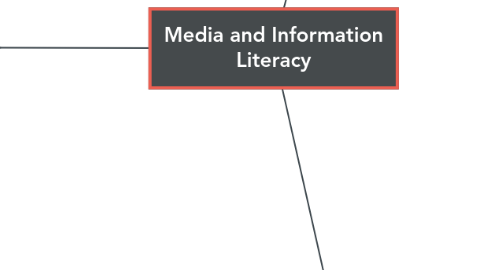
1. Lesson 1: What is Media?
1.1. Defining Media
1.1.1. helps us spread information in different forms and devices.
1.1.2. It also helps us to improve the way we communicate with other people
1.2. The Communication Process
1.2.1. helps us to know the flow of the conversation between people
1.2.1.1. Sender or Source - The individual who initiates the converstation and called the source of information
1.2.1.2. Message - The information that was transferred from the sender to the reciever
1.2.1.3. Reciever - The individual that the messenger was talking to or the reciever of the message or information
1.2.1.4. Channels - A decide used to spread the information or the message. Mostly like technology
1.3. The Feedback Mechanism
1.3.1. Add the reciever's reaction which is sent back to the sender of the message.
1.3.2. It also helps us to know if the message and the messenger was effective.
1.3.3. Shannon Weaver Model of Communication in 1949
1.4. Media as an Information Industry
1.4.1. Creative Industry
1.4.1.1. Film
1.4.1.2. Photography
1.4.1.3. Publishing
1.4.1.4. Broadcast
1.4.1.5. The sum of those characteristics that identify and differentiate human socities-a complex interweave of many factores
1.5. Media as a Culture of Entertainment
1.5.1. Culture
1.5.1.1. It is made up of its language, history, traditions, climate, geography, arts, social, economic and political norms and its system values; and such a nation's size, its neighbors and its current prosperity condition the nature of its culture
1.5.2. Examples
1.5.2.1. Korean Pop songs that became a hit in the Philippines
1.5.2.2. Marimar which became the first ever Filipino-Dubbed Mexican telenovelas in 1990s
1.5.2.3. Asian tenenovelas like Meteor Garden in late 2000s
1.5.3. Pop Culture
1.5.3.1. High Culture or High-brow art
1.5.3.2. Low-brow
1.6. Kinds of Media
1.6.1. Taditional Media - invented prior to the invention of the internet
1.6.1.1. Print Media
1.6.1.2. Broadcast Media
1.6.1.3. Film or Cinema
1.6.2. New Media - Media that developed when the use of computer technology became ordinary and common in most parts of the world
1.6.2.1. Also referred to as Digital Media
1.6.3. Social Media - Internet-maintained computer programs
1.6.3.1. Facebook
1.6.3.2. Instagram
1.6.3.3. Twitter
1.6.4. Mobile Communications Technology
1.6.4.1. Smart gadgets
1.6.4.1.1. Phones
1.6.4.1.2. Tablets
1.6.4.1.3. Televisions
1.6.4.2. Helps us when it somes to communicating, gathering information and entertainment because of its advance abilities and its portable
1.6.5. Related and emerging media habits
1.6.5.1. Gaming consoles
1.6.5.1.1. PSP
1.6.5.1.2. Xbox
1.6.5.1.3. Sony Playstation
1.6.5.2. Smart watches
1.6.5.2.1. Apple watch
1.6.5.3. Smart eyewears
1.6.5.3.1. Google Glass
2. Lesson 2: Media Then and Now
2.1. Brief History of Media
2.1.1. Because of growing and evolving world around us, a lot of inventors thought to develope a better way for people to communicate with each other and gather informations in the most fastest and simpliest way
2.1.2. Pre Industrial Age
2.1.2.1. Cave Paintings
2.1.2.2. Clay Tablets in Mesopotamia
2.1.2.3. Actadiurna in Rome
2.1.2.4. Dibao in China
2.1.2.5. Papyrus in Egypt
2.1.2.6. Codex in Mayan Region
2.1.2.7. Printing Process with wood blocks
2.1.3. Industrial Age
2.1.3.1. Printing Press
2.1.3.2. Type Writers
2.1.3.3. Projectors
2.1.4. Electronic Age
2.1.4.1. Fax Machines
2.1.4.2. Cellphones
2.1.4.3. Cable and satellite technologies
2.1.4.4. Compact discs
2.1.4.5. Sony walkman
2.1.4.6. Sony discman
2.1.4.7. VCDs
2.1.4.8. DVDs
2.1.5. Digital Age
2.1.5.1. Computers
2.1.5.2. Apple fame
2.1.5.3. Windows
2.1.5.4. SLR cameras
2.1.5.5. DSLR cameras
3. Lesson 3: Understanding Media: Aesthetics of the Image, Text and Audio
3.1. Framing and Reading
3.1.1. To constract, compose or imagine something
3.1.2. To create with a solid plan to follow using a specific structure in mind
3.1.3. Newspaper and Journalism
3.1.3.1. News
3.1.3.1.1. The communication of information on current events print, broadcast, internet or word of mouth to a third party or mass audience
3.1.3.2. Newpapers
3.1.3.2.1. Needs the element of freshness or newness
3.1.3.2.2. Usually printed on relatively inexpensive, low-grade paper such as newsprint
3.1.3.2.3. Different sections
3.1.3.2.4. 5Ws
3.1.3.2.5. 1H
3.1.3.3. Journalism
3.1.3.3.1. The collecting, writing, editing, and presenting of news in newspapers, magazines, radio and television broadcast or in the internet
3.1.3.3.2. Objectivity or facts should be presented and it is not biased
3.1.4. Books, Comics, Magazines, and the Publishing Industry
3.1.4.1. Books
3.1.4.1.1. Literatures books
3.1.4.1.2. Trade books
3.1.4.2. Comics
3.1.4.2.1. Designed into panels
3.1.4.2.2. Dialogues and descriptions are written on dialogue balloons and panel lines
3.1.4.2.3. Designed using photographs
3.1.4.2.4. Attracts lower classes
3.1.4.3. Magazines
3.1.4.3.1. Format popular among adults and teens alike
3.1.4.3.2. Contains printed stories or essays, illustrations and photographs, and pages of advertising content
3.1.4.3.3. Periodical or regular schudule when it comes out, usually every month
3.1.5. Photography and Timeless Image Concepts
3.1.5.1. Photography
3.1.5.1.1. The process of recording images through a chemical interaction caused by light rays hitting a sensitized surface
3.1.5.1.2. Involves composition in analyzing a single frame or shot
3.1.5.1.3. Involes lighting and focus for us to notice when looking at a photograph
3.1.5.1.4. Shadows and highlights could further determine the emotional focus sought by the photographer
3.2. Framing and Listening
3.2.1. The art of listening
3.2.2. Radio and Evoking Imagination
3.2.2.1. Radio
3.2.2.1.1. Most popular form of mass media all over the world
3.2.2.1.2. It uses frequency and transmitters to reach even the remotest of places that has radio set
3.2.2.1.3. Most practical form of media to have in rural or remote areas
3.2.2.1.4. Serves us from the background in our daily lives
3.2.2.1.5. Clearer and high pitched of voice are needed to capture the ears of the listeners and for them to understand the indormation you were saying
3.2.2.1.6. One chance medium or you cannot go over information that has already been delivered in the way you would be able to do with newspaper
